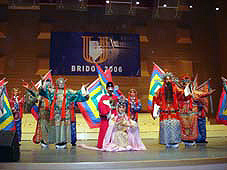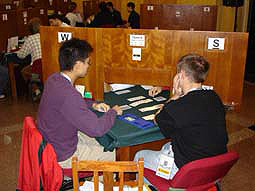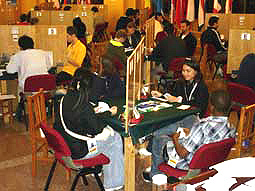The Magic of China
Hats off to the organizers who offered us a very friendly tournament, combining tradition and excellence
The Chinese University Sports Association is very dynamic this year, taking charge of two championships. After badminton (see page X), it also hosted the bridge tournament in the city of Tianjin. Bridge made its debuts in the FISU programme in the 1990s, when enthusiasts of the game contacted Paul Magerman (who was the President of the European Community Bridge League at the time) to set up a bridge tournament at University scale. From the start of the adventure, FISU offered its patronage, so that the first European Union Bridge Championship was quickly put in place. In 2000, this championship became worldwide when the first edition took place in Maastricht as part of the ” Bridge Olympiades”. With recognition by FISU, the first World University Bridge Championship finally took place in Bruges in 2002. Then the city of Istanbul took charge of organizing the second edition.

Tianjin City, located 120 km southeast of Beijing, had already sponsored the national University Bridge Championship in its own university (Tianjin Normal University). And this time, it hosted the international version of the competition. There is no denying that the Chinese organizers did everything they could to ensure the success of the event. As Geert Magerman, the technical delegate responsible for Bridge at FISU put it: “When I met the people on the Organizing Committee for the first time, they showed me their sense of hospitality plus enormous motivation.
Coming back today, I can see that my first impression was below the mark. We are enjoying a magnificent championship with an impressive cultural programme, flawless organization and, the cherry on the cake, a very exciting competition”.

o explain the popularity of bridge with students, we can also mention that the game is increasingly structured at university level – in fact, a special Internet platform has been developed for it (www.unibridge.org). All of this was made possible thanks to the unwavering support of the World Bridge Federation (WBF). Its President, Mr. Jose Damiani attended the competition in Tianjin to show his great interest in University tournaments. FISU and WBF joined efforts as they signed a convention (as they have done with international federations for archery, wrestling, karate, boxing and floorball) so that they can envisage even closer collaboration.
For this third World University Championship, 27 teams from 22 countries came to China. Participation has substantially increased as compared to the second edition, with 15 countries enrolled. All participants were given accommodations in Tianjin University in rooms that would suit a three-star hotel. The area reserved for the games was very close by, so participants could go on foot. The tournament got great coverage in the press and from several local radio and television stations.

The Scandinavian countries, particularly Norway, got off to the best start in this tournament. It is true that Norwegian students took the European Cup in Rotterdam in 2005. But as the rounds went by, it became increasingly clear that the China A team, consisting of four women and two men, would prove to be the strongest. The four girls from Liao-Nig Province have been playing together for 10 years and have got excellent results in many national competitions.
The two men, one a student at Tianjin University and the other studying in Qinghua, joined the team six months ago. They all trained intensively for two months before the championship. But above all, they analysed the play of their potential opponents very carefully, based on the principle that “knowing your opponents as well as yourself is needed to reach victory”. And that is just what they did, as they were crowned “World University Champions” with a comfortable lead over the USA and Poland. Actually, Poland has always been very well represented in junior competitions.
It would be hard to end this article without cordially thanking the many volunteers who gave their time so generously to ensure the comfort and pleasure of the contestants. Actually, there was such an enthusiastic crowd at the airport that the bridge players thought a popular Head of State was coming in – they were wrong, the welcome was for the students! Rendez-vous at the next World University Championship in Lodz, Poland in 2008.